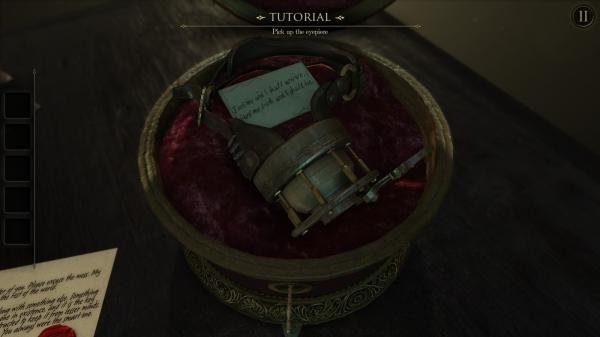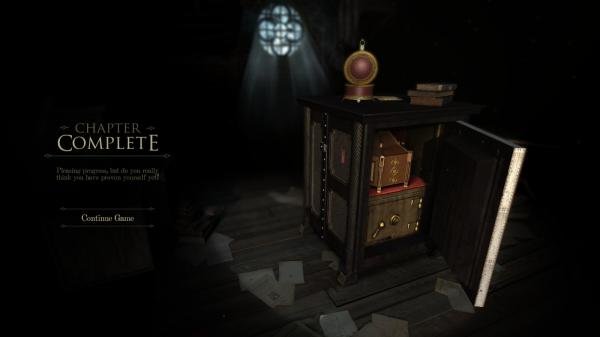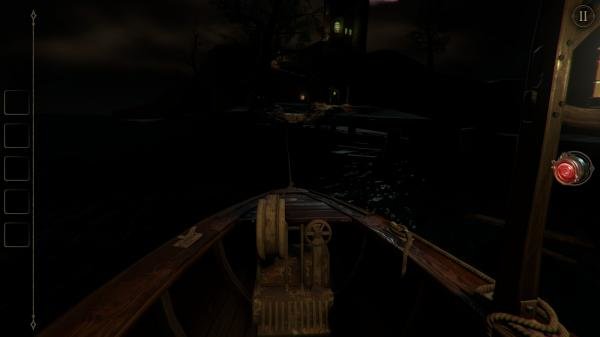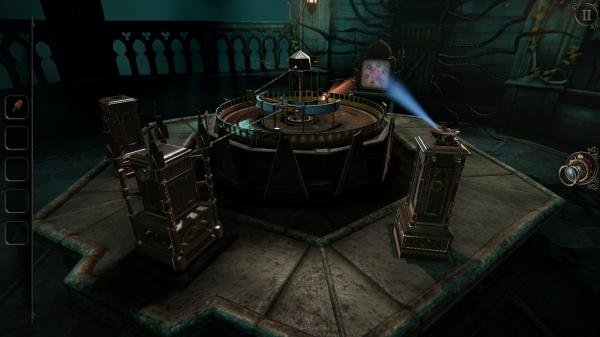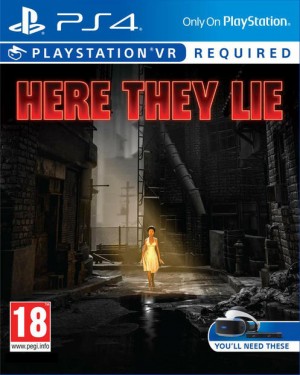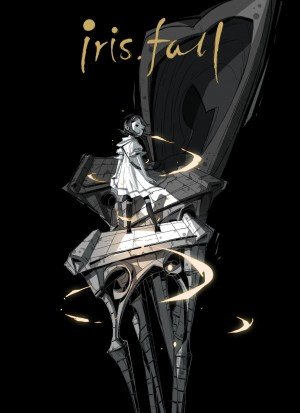Review for The Room Three
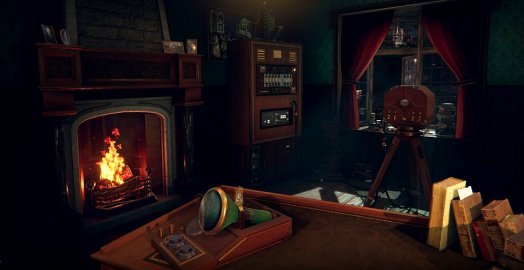
Note: Though the article content is the same, the reviews of The Room and The Room Two have been published separately with their own individual ratings.
Since its release in 2012, The Room has widely been regarded as one of the best pure puzzlers to come along in years. Strong on tightly-integrated puzzle design and mechanics in a single location, it is equally light on plot, with just a hint of a story revealed via notes as you progress. When The Room Two came along in 2013, the puzzles were better than ever, and a few additional adventure elements crept in, with an expanded environment and the continuation of the mystery teased in the first game. It wasn’t until The Room Three arrived in 2015, however, that the series really came of age as a more fully-rounded adventure game, with ongoing innovation in gameplay as well as increased exploration, deepening plot, and even some character development. With the latest chapter (Old Sins) currently available for mobile devices, and the first three games now available on PC, now seems like a good time to evaluate the series to date.
The Room
The first game in Fireproof Games’ series is certainly a solid opening entry, with great puzzles and an atmospheric (if rather claustrophobic) presentation. With no explanation, you find yourself in a darkened room, perhaps an attic of some kind with a single lamp and window illuminating only a mysterious safe-like box sitting on a table. Your task in The Room is to unlock the secrets of this box using the clues and tools provided. Before you begin poking around, an unskippable tutorial walks you through the game mechanics. Initially developed for mobile devices, the interface transfers well to the PC, with a double-click replacing the double-tap to zoom in, move or interact, right-click replacing the “expand” gesture to zoom out, and click-and-drag replacing the swipe movement to manipulate objects or rotate the camera. Hotspots are not indicated so you’ll have to guess which elements might be interactive, but since the play area is very confined this does not prove to be an issue.
The graphics and sound on PC are far superior to the mobile version. The room, box and inventory items are rendered in hi-definition 3D with smooth manipulation of objects and transitions between views. In the beginning, the background music is subtle and soothing, but becomes more ominous as you progress. It never gets repetitive, in part because it does not continue all the time, stopping completely at particular parts of the game. When not playing, there is a sound of emptiness (like the low, faint hum you hear when alone in a closed room that is otherwise silent) which is spooky and adds nicely to the atmosphere. Sound effects are spot-on when interacting with levers, sliders, and buttons, and a unique one plays for specific actions such as equipping a lens, collecting an inventory object, or as hints are revealed. Later in the game you will hear creaking sounds, background voices speaking in tongues, footsteps in the background, etc. that ratchet up the tension level effectively.
Almost immediately you are introduced to a brilliant game device – the lens! Once equipped simply by clicking its on-screen icon, you can view your surroundings through the lens to reveal images that you cannot see otherwise and are essential to solving the puzzles, though it seriously restricts your normal view so you won’t want to wear it all the time. You will also soon learn that while you cannot combine objects in your inventory, you can manipulate them directly, which is also vitally important at times. These two elements are very refreshing and add a lot of fun to the usual puzzle-solving formula. Like a Russian nesting doll, once you have opened the first box, you will discover another box inside that ends chapter one. In chapter two your job is to figure out the secrets of this new box, which contains new clues and puzzle dynamics. Similarly, once that box has been solved, it opens to reveal yet another new box to solve. These ever-deepening levels and different types of challenges keep the gameplay both surprising and rewarding.
The puzzles themselves are quite varied and often multi-layered, so you need to keep track of the clues provided in order to solve them. A good example is where you must open a drawer by adjusting the corner pieces in a specific way. Doing this requires complete examination of the box to find the knobs that need to be turned (and first discovering a hidden compartment for one of them). Other tasks you will encounter include aligning a beam of light, adjusting keys in inventory to the right shape to fit locks, revealing codes in hidden videos, and many more. The sheer diversity of obstacles, all confined to a single area, is truly amazing. While most of them are inventive and well-designed, I found the pattern-matching via rotation of objects (mainly using the lens) to be a bit repetitive, but that is a minor quibble.
Hints can be enabled, appearing after a time delay in the form of a question mark at the top of the screen. Clicking on this icon will reveal the first hint. If you are still working on the same puzzle, an additional hint (if available) will emerge after another short wait. In most cases you will get a nudge in the right direction with the first hint, and if you are still stuck the next hint will tell you what you need to do. This works well, but if multiple hints are available you cannot go back to review an earlier one if you forget what it said. Other clues are far more organic, provided via item descriptions when you click on them. For example, you might be told “It smells of burning,” suggesting that you need an element of fire to interact with that object.
Although predominantly a puzzle game, there are traces of a larger adventure in the form of notes left by a mysterious figure known only as A.S. These messages hint at something called the Null Element, which holds incredible power. This narrative forms an overarching storyline through all three games (so far) and should serve to hold your interest throughout the series, though no answers or closure are provided in any one installment.
Your progress will be automatically saved when you exit the game, so you can pick up right where you left off in the next session. Once you have completed a chapter (there are five in total), you can replay any of them. I spent between 5-6 hours solving the many challenges and really enjoyed my time, but I did not find the need to revisit previous chapters as all the solutions are the same.
While not as difficult as The Witness or The Talos Principle, the gameplay here is original and addictive, so if you love puzzle games, The Room is highly recommended. Almost all of your time is spent in a single room, as its title suggests, but there is a cliffhanger at the end that whisks you off to an unknown location to set up the next installment.
The Room Two
Upon starting The Room Two, a new feature is revealed in which three different profiles can be created, allowing for multiple players. Otherwise, the game mechanics are exactly the same as its predecessor’s, including an unavoidable tutorial to get you started. You will begin in the room you were transported to at the end of the first game, still without so much as an explanation of where you are or why you’re there. This room is also dimly lit, with a square table in one corner and a hexagonal table in the other, each of them with interconnected puzzles to solve. Unlike the single-scene original game, from here you will be transported to several different locations, including a ship at sea, a cave, a temple, a séance area, an island mansion, and finally an inter-dimensional location before escaping the estate of the mysterious A.S. To get to these places you must first solve another wave of innovative and interesting puzzles in each room to activate a portal to the next – a nice transition element.
Along the way, you will discover a number of notes and messages from various sources that will make you want to find out more about what is happening. (In some cases these notes provide clues to the puzzles, so you need to read them all anyway.) A.S. is back, continuing to document his/her efforts to discover and obtain the Null Element – as well as provide some help and encouragement – but you will also learn of a seedy man named Mr. de Montfaucon, a new character hired to obtain an unnamed artifact. There is also evidence of some rather grisly experiments being conducted on humans to deepen the mystery. These story elements elevate The Room Two from a pure puzzler to a lite adventure game, making it more interesting to play from a traditional adventure gamer’s point of view.
That is not to say the puzzles are diminished; in fact it is quite the opposite. Fireproof continues to impress in this outing with inspired puzzles that, while still not terribly difficult, are very fun to play and satisfying to solve. Gone are the boxes from the first game, replaced here with a wide variety of organic-based puzzles specific to the current location. Many require you to align objects to reveal the next item needed (such as a key or an orb), but several are progressive, as in the previous game. For example, you will need to maneuver a model ship through a maze, but in order to unlock sections of the maze you will need to solve riddles exposed as you go along. Of particular note is the laser puzzle that requires interaction with many objects in the room (and solving puzzles in the process) to obtain another lens to find the clues needed to progress to the final escape. Just brilliant!
Accompanying these elements are the same great 3D graphics and sound effects from the first game that will continue to immerse you in the more varied environments this time around. The multiple locations aren’t just for decoration either, as they provide more gameplay options than just a single room, which in turn extends the play time. It took me approximately ten hours to complete The Room Two, and I enjoyed every minute overcoming the creative new challenges. There are several storyline threads sewn in between the many enjoyable puzzles as well, so by the time I was finished I was very much looking forward to the next chapter in the series.
The Room Three
In The Room Three you find yourself on a train, unsure of where you are going. Without warning, a shadowy figure appears for just an instant and then disappears to reveal a mysterious box on the table in front of you. Once you solve that challenge, you are taken to the game’s main location: Grey Holm, a mansion on some unknown island. Here you learn of a new character, The Craftsman, via more mysterious notes scattered about (as well as a brief glimpse of him through the slot in the door to the main hub area), and are challenged to collect five pyramid objects to unlock the mysteries of the Null Element. The Craftsman is continuing the efforts of A.S to solve this mystery, and you are quickly drawn into his/her scheme whether you like it or not.
Once you solve a few more introductory puzzles requiring you to interpret riddles on a triangular table, a new feature is introduced: an additional lens for your eyepiece that allows you to actually explore inside various objects. The lens lets you enter miniature areas of the environment (highlighted by a sparkling light as they are uncovered) to solve puzzles specific to that location. This new ability is used extensively throughout the game in place of the traditional lens from the first two installments and adds a fresh perspective to gameplay.
Another welcome change is the ability to review previous hints if there are multiple tiers. This may seem like a small thing, but the hint text disappears fairly quickly, and in previous games you were not able to revisit them unless you quickly wrote them down. In addition, a visible timer (not present before) now counts down to the next hint, a cool feature for the impatient gamer like me. One curious difference is no longer permitting players to replay completed chapters; you are able to restart the current chapter, but you cannot go back to earlier ones. It’s an unusual omission, but perhaps in keeping with the increasingly adventure-oriented nature of the gameplay this time around.
When I first arrived at Grey Holm and figured out how to enter the main lobby of the mansion, my initial impression was that there was much to explore and so where to begin? Alas, the series’ penchant for linear progression persists, in that you need to unlock a specific door first, then solve the puzzles in that area before you can open the second door (which is itself pre-determined) and so on. While I would have much preferred the freedom to choose where to go in the order I wanted (in “true” adventure game style), each of the five parts of the island is unique, beautifully rendered, and meticulously crafted to provide a great gaming experience.
You will need to repeat the same steps to open the portal to each region, but there is sufficient variety in the way this is done to not feel too repetitive. Once in a new location, you’ll find a lot of diversity in terms of both scenery and gameplay. The first place you visit is an impressive topographical model of the island with many sections to explore and solve. This one puzzle makes up the bulk of chapter one, with ever-expanding areas to interact with as you gather the necessary items. Conquering this challenge requires interaction with a typewriter, which provides an object to access a spot on the map, which in turn grants passage to a Stonehenge-type area accessible via the new eyepiece, and so on. Once you have solved what you think are all the puzzles, the table rises to an attic area where there are even more varied puzzles to solve.
After you complete each area, you will receive a pyramid that must be placed on the altar in the lobby to unlock the next chapter’s location. Each of the five chapters provides not only a new location but different gameplay as well. In “The Clock Tower” you will need to solve many puzzles to set the clock to the correct time, while “The Forge” sends you to a foundry where you must forge three different keys to unlock the next pyramid. The remaining chapters are similarly diverse. While these areas play out independently, the purely mouse-driven game mechanics and process for moving on remain the same in each.
Once again the puzzles are for the most part addictively engaging. Having said that, the developers did manage to sneak in a maze – the bane of countless adventure gamers everywhere – in the final chapter. It has a twist that makes it less of a chore, but still! In addition to the game’s hint system, notes from The Craftsman can sometimes provide useful guidance in the right direction, along with expanding the story and deepening the plot.
Upon reaching The Room Three’s default ending, you will encounter Mystical Maggie, a mechanical fortune teller with whom you will need to interact as your character is trapped in an eternal labyrinth. After that the “Change your Fate” option appears in the game’s main menu, enabling you to explore three alternate endings. Here the game gets a bit tricky in that hints are no longer available; you are on your own to solve the remaining puzzles. I must confess I needed to consult a walkthrough to complete all of the endings, as some of the puzzle interactions are hard to detect. For example, in one particular place is an object on which you need to use your mouse in a specific way, but the effect of this interaction is so subtle it’s easy to overlook.
The alternate endings are varied and interesting, each revealing a bit more information about The Craftsman and other characters mentioned in earlier notes, but two of them left me wondering how the next game in the series would continue. And while I very much enjoyed these alternate takes, I did not appreciate the need to repeat the end-game puzzles each time I arrived. They are not difficult, but proved to be a tedious experience to solve multiple times. Perhaps this was designed to pad the gameplay, but at a solid 10 hours already for a single playthrough, it really wasn’t necessary.
While still highly streamlined, it is clear that with The Room Three the series has finally come of age as not just a puzzle franchise, but as a full-fledged adventure series in its own right, with no signs of stopping any time soon. The added elements endeared this third game to me even more than the already impressive first two, and made me care about what happens next. The introduction of The Craftsman and his motives hints at much more than meets the eye and really piqued my interest. The fourth installment has already been released on iOS and Android devices, and I can hardly wait for it to make its way to PC so I can continue this thoroughly entertaining puzzle-filled journey.
Our Verdict:
The best game yet in the series, The Room Three is the first to really qualify as a full-fledged puzzle-adventure game, with varied areas to explore, an assortment of new challenges to overcome, and a continuation of the intriguing storyline established in earlier games.



